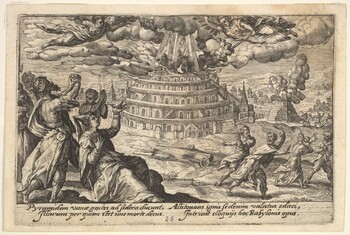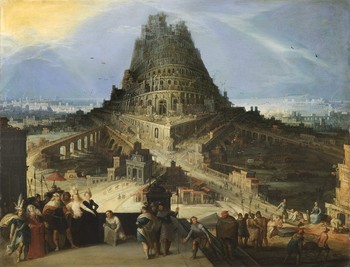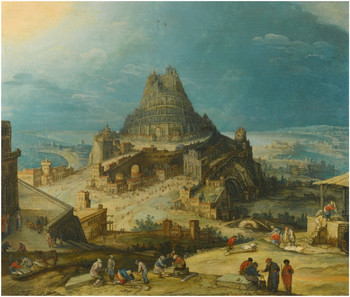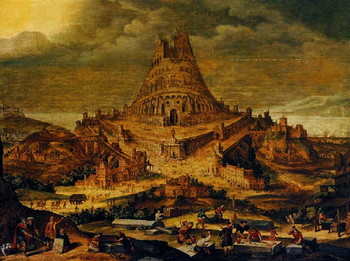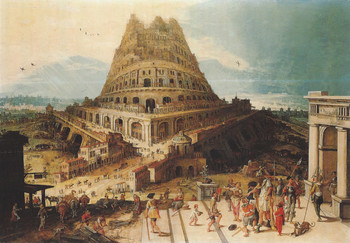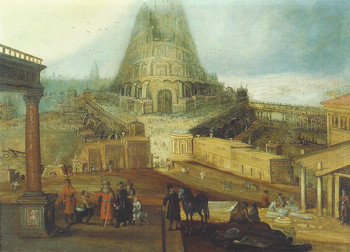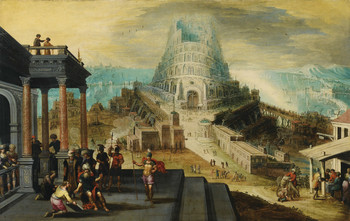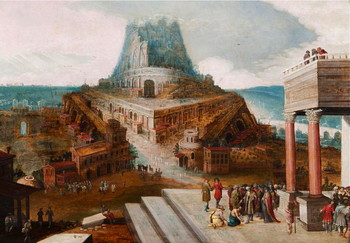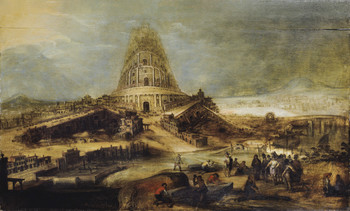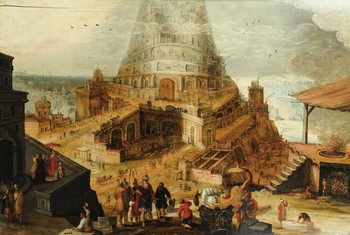Unidentified Flemish painter from Antwerp, circa 1580/1600 from “The Hendrick van Cleve III Group”
The Tower of Babel
Oil on panel : 41,3 X 47,5 cm
Unsigned
Otterlo, Kröller-Müller Museum
This is a comparative item
Painting for Sale
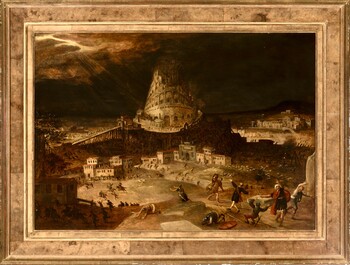
Unidentified Antwerp painter, circa 1590/1600
"The destruction of the Tower of Babel"
In short
The Tower of Babel is one of the most emblematic subjects of Flemish Humanist painting of the second half of the 16th and first quarter of the 17th century. The first book Genesis in the Bible tells how God was angry at man for trying to build a tower that would reach into heaven. He created therefore all sorts of different languages so that the builders could no longer understand each other; the tower was never finished.
An important number of paintings representing the Tower of Babel used to be attributed to Hendrick van Cleve III, although none of them is signed. It is known today that these paintings were made in the last quarter of the 16th and the first quarter of the 17th century by yet unidentified painters.
Our painting represents the destruction of the Tower: it is a rare subject, which was not often painted or engraved.
About the Tower of Babel: pride destined to fall
In the Old Testament the first book Genesis (11:4-9) holds the story of the Tower of Babel, which explains the origin of all different languages.
As mankind had become evil God destroyed all with the Great Flood, except Noah and his family and a pair of all species of animals. They survived thanks to the Ark that God had instructed Noah to build.
Humanity then spoke a single language.
People from later generations from the city of Babel (Babylon) wanted to build a tower tall enough to reach heaven. This angered God, who saw their behaviour as disrespectful. He confounded their speech so that they could no longer understand each other and scattered them around the world; the tower was never completed.
The Jewish verb “balal” means to confuse or to confound.
In Genesis (10:10) it is only said that Babel formed part of the empire of King Nimrod. But other sources, such as Titus Flavius Josephus, the Jewish-born Roman historian (37 AD – circa 100 AD), interpreted this differently: the arrogant tyrant Nimrod, the great-grandson of Noah, was the builder of the Tower of Babel.
The Tower of Babel refers to the ziggurat of Babylon, which the Jews saw during their captivity there in the 6th century BC. On top of the 91 meters high tower in the form of a step pyramid stood the temple of Marduk, the main god of Babylon. Ziggurats were constructed with sun-dried mud bricks. The ziggurat of Babylon was built by the Neo-Babylonian King Nebuchadnezzar II (circa 634 BC – circa 562 BC). It replaced an older one that had been destroyed by the Assyrian King Sennacherib. The Greek historian Herodotus described the Tower after his visit to Babylon circa 460 BC. By the time that Alexander the Great (356 BC – 323 BC) captured Babylon in 331 BC the ziggurat was already in bad shape. He ordered its destruction to prepare for a final rebuilding, but the young Macedonian king died that same year (323 BC). Others after him made several attempts of further demanteling, destruction and rebuilding, but without any success.
About the Tower of Babel in Flemish painting
This subject was very popular in Flanders in oil painting in the second half of the 16th century and the first quarter of the 17th century. Pride destined to fall: did it refer to ancient Rome, was it a warning for the merchants of Antwerp, or should one see it as an indictment of the arrogance of the Catholic church? This impossible undertarking full of overconfidence and incompetence was typical of this wrong world.
Pieter Brueghel the Elder (1526/30 – 1569) painted three version of it, two of which are preserved. The large version from the Kunsthistorisches Museum in Vienna dates from 1563; the smaller version from the Boijmans van Beuningen Museum in Rotterdam must date from the very end of Brueghel’s life, circa 1568. Brueghel saw the Tower as a circular building with an exterior spiraling ramp climbing higher and higher.
In the Vienna version Babel is represented as a busy harbour town; in the foreground King Nimrod supervises the works. The circular tower, the town and Nimrod appear in many pictures of the Tower.
Between 1552 and 1554 Brueghel had travelled to Italy. His architectural design of the Tower of Babel must have been inspired by the Colosseum in Rome, which he saw in real. This was also the case of Hendrick van Cleve III (circa 1525 – circa 1589) who visited Rome between 1540 and 1545. A lot of representations of the Tower of Babel have been attributed to him, often more wrongly than rightly.
This is strange, for only two representations of the Tower can be more or less securely attributed to van Cleve:
- a monogrammed and dated (1684) drawing from the Statens Museum in Copenhagen;
- the painting sold as “circle of Abel Grimmer” at Christie’s London, 10/07/02, which shares a lot of similarities with this drawing. Elise Boutsen in her master thesis (2014/15, P. 61 – 64) gave it in full to Hendrick van Cleve III, but at the RKD in The Hague it is called “attributed to Hendrick van Cleve”.
Clearly the elements typical to this drawing and to this painting can not be found in most of the paintings that used to be given in full or attributed to Hendrick van Cleve III.
Other Flemish painters who regularly painted the Tower and to whom Towers of Babel have been attributed are Lucas van Valckenborch (in or after 1535 – 1597), Tobias Verhaecht (1561 – 1631) and Abel Grimmer (1570/73 – after 1620).
In the last quarter of the 16th and the first quarter of the 17th century several unidentified painters from Antwerp continued painting Towers of Babel. Typical of these painters is a Mannerist frivolity in its interest in architecture, the great fascination for the imaginary town of Babel and the attention paid to the figures in the foreground. Often one has a panoramic view of the foreground, town and surrounding landscape, while the Tower is seen from beneath.
Why should you buy this painting?
Because while the Tower of Babel is an icon of Flemish late Mannerist painting, representations of its destruction, such as our painting, are extremely rare.
Comparative paintings
Click photos for more details


